There are a bunch of Pardee built homes in the Southwest part of Las Vegas (Spring Valley) where at one time this reporter spent a number of great days racing around on a very-special racetrack. It was simply called, among the competitors and locals, the Stardust Raceway. Its official tile was The Stardust International Raceway.
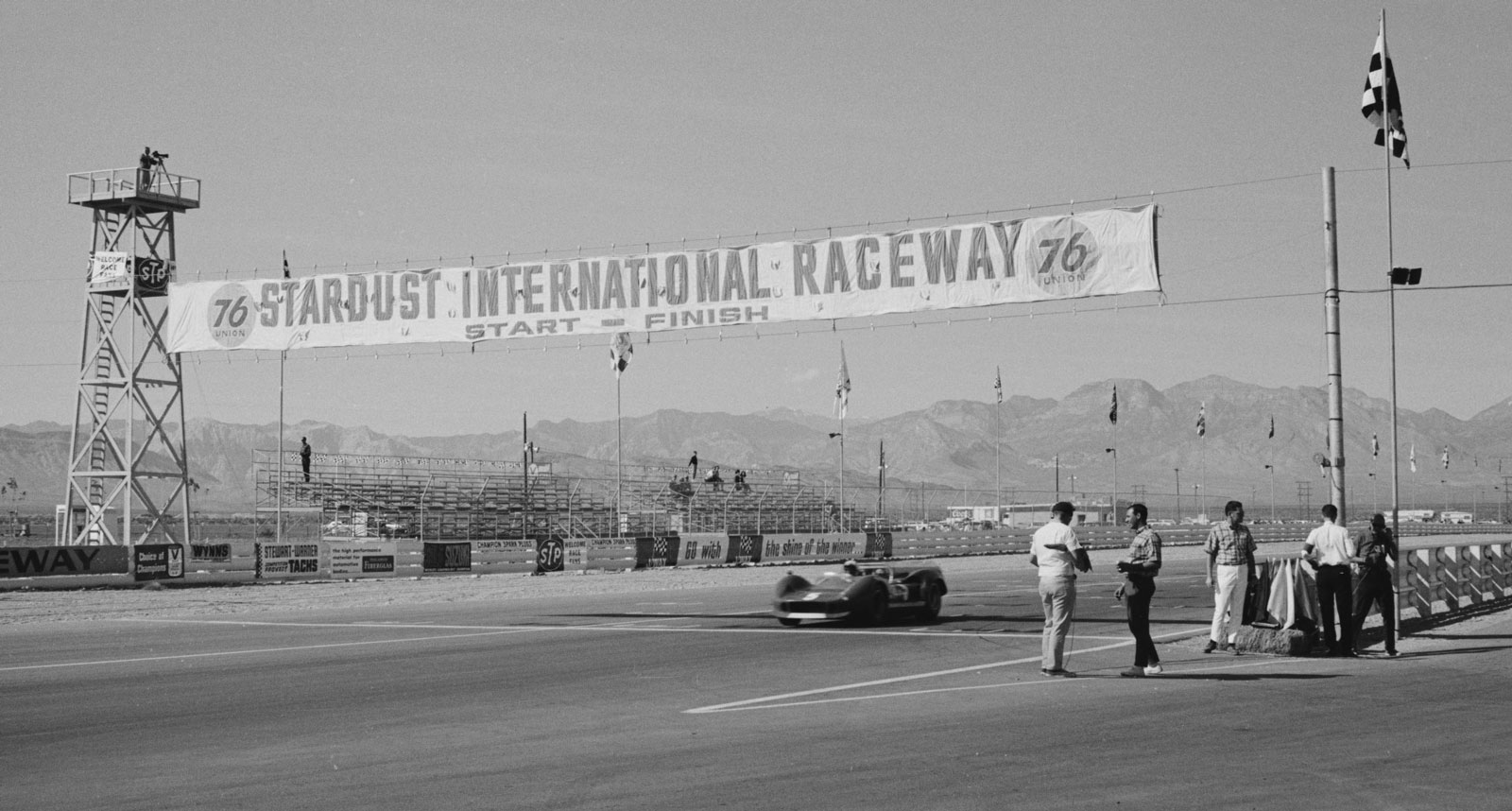
It was an auto racing track and featured a flat, 3-mile (4.8 km), 13-turn road course, and a quarter-mile drag strip. The Stardust was developed in 1965 by the Stardust Racing Association, a Nevada corporation headed by the primary owner of the Desert Inn and Stardust Hotel-casinos and was developed ostensibly to attract high-rollers to the Stardust hotel. The Stardust Racing Association owned the property and functioned as the event promoter. In 1966 it began hosting the season finale of the Can-Am championship.
In 1965 I was the new featured sports columnist for the Las Vegas Sun, and I of course was 100 percent in favor of anything they did, because it was auto racing! I remember they held a few races for the locals, which were OK but nothing to brag about. There was only one slightly paved road leading to within a mile of the track. Then you had to turn onto a dirt road, which also included a few gully’s and one creek, you had to cross to get to the actual track. The press box was exactly that a square windowed box able to seat maybe 10 reporters at its best. And no air-conditioning at first.
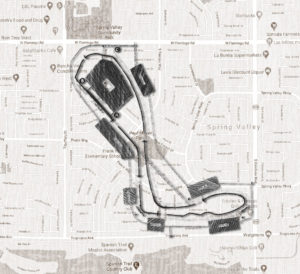
In 1968, after I had created the Mint 400, there was an interesting event to be promoted by the hotel and an off-road race promoter. The following is my original story as printed in my book, “The Off-Road Racer 1976.” I have taken the liberty of editing it very slightly for space saving:
Nevada has been the site of many great races, some of which still exist. One of the greatest tests of machine and man in Nevada, though, was a one-time event staged in the heat of summer: the Stardust 7-11 Off-Road Race, created by NORRA and its president, Ed Pearlman. When the Mint Hotel in Las Vegas was planning its first “Mint 400”, NORRA was one of the first organizations contacted to help promote the event. Pearlman met with Norm Johnson and other hotel officials on at least two occasions to discuss the proposed race. But eventually, Pearlman opted for his own promotion in conjunction with the Stardust Hotel on the Las Vegas Strip.
Leo Margolian, director of racing for the Stardust, which owned the Stardust Racetrack on the outskirts of Las Vegas, and NORRA had arrived at a mutual financial arrangement to promote a giant off-road race. They would use the track itself as the start/finish and main pit area. The date of the race was announced as Wednesday, June 12, 1968. Pearlman believed at the time that the Mint would not go forward with their planned race. But the Mint 400 was held in mid-April with a guaranteed purse of $15,000, and a total of $15,000 in contingency sponsored money.
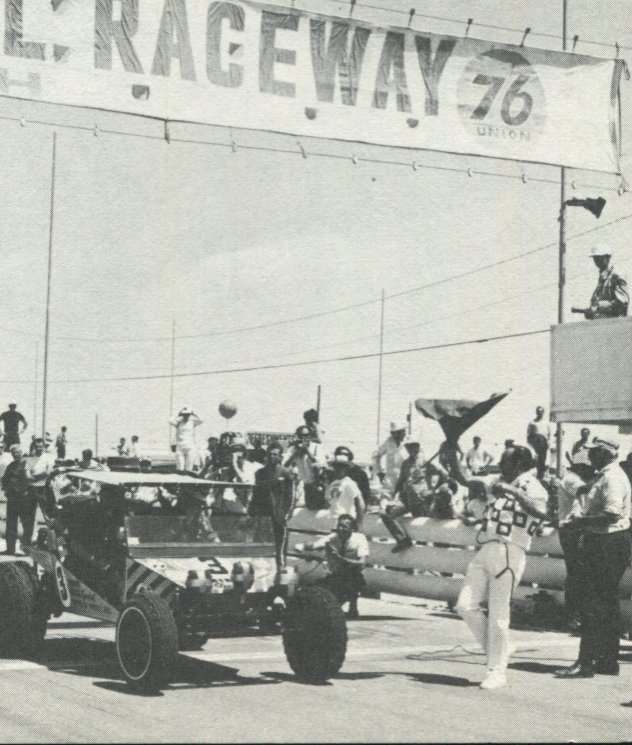
A guaranteed purse of $25,000 (out doing the “Mint 400” guarantee by $3,000) was established, immediately making this the richest race in off-road history. Distance of the event was 711 miles, consisting of two 355-mile loops. It would be a monster. Most of the course was the one designed for the Mint 400, with one main exception. In the first Mint, a 10-mile portion of the course consisted of giant rocks and was practically impossible to navigate without cheating. As a matter of record, many cars that got to that particular section of the Mint 400 were seen racing on a paved highway that skirted the rockpile. Pearlman eliminated this section by using the paved highway as part of the course and placing a time limit between the two checkpoints on the road, thus preventing the racecars from speeding on the highway.
Promotion by NORRA and the Stardust was top-rate. It began before the Mint 400 ran in April, and considering the number of entries in that race, the organizers knew the 7-11 would be successful. By the time race week arrived, a total of 141 entries had been received and processed. Among those who had sent in their entries were two names new to off-road racing, actors James Garner and Steve McQueen. The field consisted of every type of vehicle built, including some unique cars. An example of the growing interest in off-road racing was a formidable entry from Holman-Moody and Stroppe, which consisted of five Ford Broncos.
McQueen would drive a Vic Hickey-engineered and -built, General Motors-sponsored car dubbed the “Baja Boot”. His co-driver was Bud Ekins, the first man to establish a record on a motorcycle in Baja, considered by many to be one of the greats in this new sport. The Boot was a monster of a car with an Oldsmobile V-8 engine and specially designed Goodyear tires. It literally shook the ground when the engine was revved. An engineering marvel, the Boot was beautiful in design. McQueen was not able to finish because of mechanical problems—but he tried.
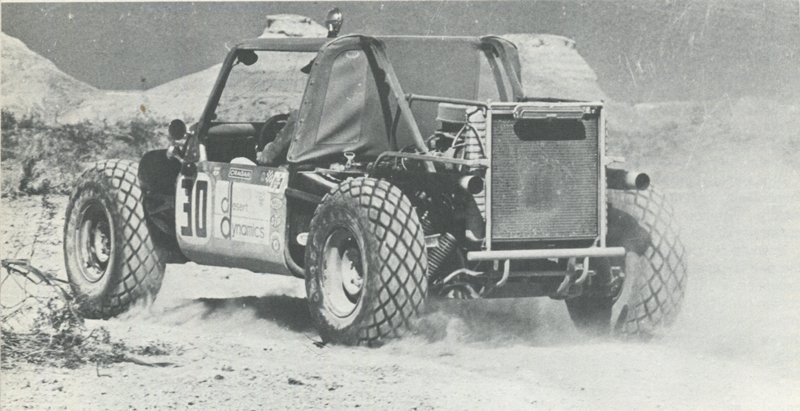
Garner also was considered a favorite. His co-driver was none other than Scooter Patrick, veteran of many an oval track. They would be piloting a new, Porsche-powered, Meyers Manx two-seat buggy. The Manx broke down and did not complete the first lap.
The Del Webb Corporation, owners of the Mint Hotel, entered three cars. Driving these cars would be executives from the corporation who had just finished competing in their first race, the Mint 400. These included Bud James, President of the Del Webb Nevada operations, and John Romero, Publicity Director for the Sahara Hotel, in a Porsche-powered, two-seat buggy; Earl Thompson, Executive Vice-President of the Sahara Hotel, and James Dean, Entertainment Director for the Sahara, in another Porsche buggy; and Norm Johnson, Publicity Director at the Mint and creator of the Mint 400, with Fred Sikorski, chief engineer at the Mint and a veteran dirt-bike racer, in a Burro powered by a 36-horsepower Volkswagen. It was reported reliably that the three vehicles entered by the Las Vegas drivers had a side bet of $1,000 each, to be won by the car going the farthest in the race.
Cars and motorcycles were assigned starting numbers in a drawing held at a huge press party in the Stardust Hotel a few weeks before the event. Each vehicle was given a time limit of 40 hours to complete the race. Of the 141 entered, 137 vehicles actually started the race. The first vehicle off the starting line at 11 a.m., June 12, 1968, was a 1967 Jeep from Las Cruces, New Mexico, driven by Lonnie and Donnie Beyer. First bike away from the Stardust race track was Eddie Muler with co-rider Ron Nelson. The Johnson-Sikorski entry was third off the line.
Mel Larson, who was later to become Race Director for the Mint, was behind the wheel of the Claimjumper, entered by Don Arnett. Arnett and his crew worked feverishly the night before the race to make the starting grid, only to have the car forced out of the race by fuel problems within the first 30 miles. “Hell, I was sitting in a pool of gasoline,” Larson explained later. “There was more gas on the floor than there was in the tank.”
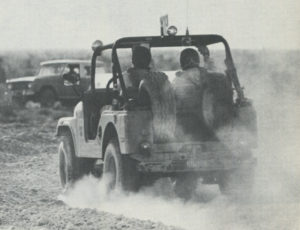
Another interesting entry was from the Desert Inn Hotel on the Las Vegas Strip. The hotel featured a “girlie” show in its main room, “Pzazz 68”, and decided to publicize this show at the race. The pit crew for the Desert Inn entry consisted of the entire chorus line from the show. It was the best-looking pit crew ever assembled. Unfortunately, the car did not perform as well as the pit crew.
Naturally, the Baja Boot received a lot of attention from the hundreds of cameras stationed in the pit and at the starting line. McQueen’s wife, Neile, had taken the time to paint a little flower on the rear of the car. “Hey, what’s the flower for?” a reporter asked.
“For good luck,” McQueen replied. “This is, too,” he added, showing a “love bead” necklace around his neck. “Neile’s taking no chances!”
The Boot did not finish the race, even with the help of the flower and “love beads”. An interesting thing did happen, however, which deserves reporting: Troubled with overheating, the two racers were forced to stop on the edge of a dry-lake about 35 miles before checkpoint two, which was located at Ash Meadows. After repairing the problem, they started across the lake, only to break a ball joint on the front suspension. Hickey, back at the Stardust, received word that McQueen needed a ball joint. After hearing the announcement of the need for the part over the public address system at the track, a spectator who owned a 1967 Olds Toronado volunteered his car for parts. A complete crew of mechanics, with the borrowed parts, was transported to the broken Boot and repairs were made. However, within a few more miles the Boot took its final mile and pulled over to the side. Steve was eventually picked up by a helicopter and returned to the racetrack to be on hand to greet the eventual winner.
The first vehicle across the finish line after one lap was Larry Berquist aboard a 305 cc Honda, where Gary Preston took over for the final lap. At exactly 12:20 a.m., Larry Minor and Jack Bear entered the Stardust race track, completing lap one. Their Holman-Moody and Stroppe-prepared Bronco was performing as perfectly as the pit crew—it took only 15 minutes to change tires, refuel and make a few minor repairs before the Bronco was out on lap two. The first dune buggy, and fourth vehicle overall, to enter the track was the Burro driven by Johnson and Sikorski in 14 hours and 12 minutes. The other two Webb entries failed to complete the first lap. The Johnson team collected the $3,000 side-bet between the Webb racecars.
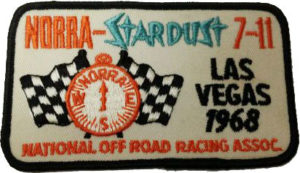
It was 10:30 a.m. the next day (Thursday) when Preston crossed the finish line and received the checkered flag. They had completed 711 miles in 22 hours and four minutes for the overall win. The first four-wheeled vehicle to cross the finish line was the Bronco driven by Minor and Bear in 27 hours, 14 minutes. Of the 137 vehicles, only 30 managed to complete the race. It turned out to be one of the toughest races ever designed by any promoter. Johnson and Sikorski pulled out of the race with Johnson suffering a bad neck injury. The rules at the time stated both drivers had to complete the race. To this day I (the writer of this column) believe Fred would’ve completed the race and even caught the Bronco). He was one-hell-of-a-competitor as am I to this day!
What happened to cancel this great race? The Stardust Hotel, which had built and maintained the race track, was sold soon after the 7-11. New management did not want to sink any more money into operating the track, nor to sponsor any more races. Pearlman was given the option of promoting another event, but without the full cooperation of the hotel.
Thus, the Stardust 7-11, one of the great events in the early history of off-road racing, gave way to the now-famous Baja 500. Pearlman, however, did come back to Nevada a few years later with the hope of renewing the 7-11, but he met with various obstacles in obtaining permits and gave up on the idea. It was a great one-time race and is one of the many reasons off-road racing is where it is today!
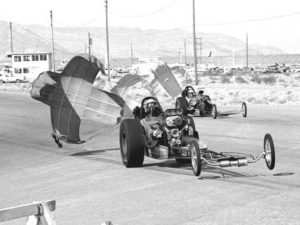
In 1968 the USAC Championship Car series held a race at Stardust. The drag strip hosted the NHRA Stardust National Open in 1967, 1968, 1969, and 1971. The Stardust Racing Association was dissolved on April 1, 1968, 1 day after the USAC Stardust 150. The hotel and raceway were sold in January 1969 to the Parvin-Dohrmann Corporation, and the new ownership closed the track shortly thereafter. Larry Horton, the track’s manager, re-opened the drag strip in August 1970 and ran drag racing events until October 1971. Real estate developers Pardee Homes acquired the Stardust International Raceway property and related adjacent properties in August 1970 and built the Spring Valley community. Pardee commenced residential development on a portion of the property as drag racing events were still in operation directly adjacent. A subsequent racing facility, the Las Vegas Speeddrome, opened in 1972 across from Nellis Air Force Base. The Speeddrome property was later redeveloped into the current Las Vegas Motor Speedway.
So, now, you know the rest of the story. Gosh I could go on an do another whole column on just the great racers who competed on the Stardust race track. But I will save it for another day.
Well, gang, that’s about it for this week.